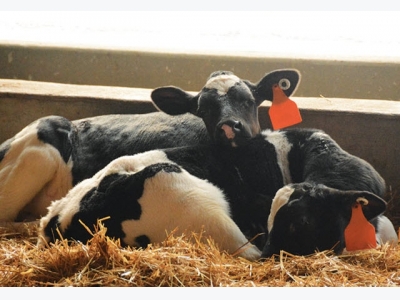Calving Basics: The First 15 Minutes

What you do in calf's first minutes can be life or death. ( Mike Opperman )
Not to put too dramatic a spin on it, but what you do or don’t do in the first few minutes of a calf’s life can impact how she performs the rest of her life.
“Events in the first 15 minutes after birth can make a lifetime of difference for newborns,” says Amanda Fordyce, a technical dairy calf consultant with Milk Products, Chilton, Wis
She lists six key areas to help calves get off to their best start:
Delivery. The natural inclination is to help in delivery as soon as the calf’s front hooves appear. Doing so can cause more harm than good, and interferes with some important natural processes. When cows deliver naturally, they often pause for a few minutes after the calf’s ribcage appears and the calf takes its first breath. At this point, the placenta transfers its blood supply, about one pint of blood, to the calf. This transfer is crucial for timely placenta expulsion and a thrifty calf, says Fordyce. “As long as the cow is progressing normally and the calf is in the correct position, with no signs of stress from the cow or the calf, the best strategy is to monitor the process,” she says.
First Breaths. If the calf is not breathing, use a clean piece of straw in the nostrils or pour cold water on the calf’s forehead. Sit the calf up on its sternum by tucking the front legs under the body. “This sternal recumbency position helps ensure airways are open and make it easier for calves to breath,” says Fordyce.
Dangling calves. Some believe every newborn calf should be lifted upside down to help clear fluids from lungs. “Research has shown this practice does indeed expel fluids, but they are contents of the stomach not the lungs,” says Fordyce. Upending the calf actually causes more stress to the animal. Internal organs press against and crush the diaphragm, making it more difficult for her breathe.
Stillbirths. “Some calves may be born not breathing but still have a heartbeat,” she says. Check for the heartbeat by feeling the heart under the left leg on the rib cage. If you feel even a slight beat, vigorously rub the calf’s chest and use the straw-poke or cold- water techniques to stimulate her. You’ll be surprised how many calves ‘wake up’ and perform just fine, says Fordyce.
Warming boxes. “In instances of very cold weather, warming boxes are necessary,” she says. “But they can actually harm calves in the long run if used for too long or not cleaned regularly.” The problem: Warming boxes become reservoirs of harmful bacteria that can easily infect newborn calves. Plus, spending 48 hours or more in a warm box can deplete calves’ internal stores of brown fat, leaving them less capable to making adjustments when they are moved to hutches. Fordyce recommends using warm boxes sparingly, up to 24 hours, until the calf’s hair coat is dry. Consider using a calf jacket or extra bedding in frigid conditions when temperatures are below 30°F.
Colostrum. “Calves can absorb critical antibodies and other immune factors from their dams only through colostrum,” says Fordyce. That ability drops rapidly after 24 hours. So once the calf is breathing normally, deliver 3 to 4 quarts of high quality, biosecure colostrum within the first 2 hours of life. The colostrum should have a Brix refractometer reading of 22 or higher to ensure adequate quality. Consider keeping a separate collection of sanitized bottles, nipples and esophageal feeders for colostrum feeding only. If you can’t milk the calf’s dam immediately, consider using colostrum from other dams or a high-quality colostrum replacer with 150 grams IgG per dose, she says.
Related news
 Protein and Amino Acid Requirements for Close-Up Dry Cows
Protein and Amino Acid Requirements for Close-Up Dry Cows In the last 20 years, research has demonstrated how much dry cow nutrition can negatively affect cow health, milk production and reproduction.
 5 Mistakes You Don't Want to Make When Choosing a Cow Monitoring System
5 Mistakes You Don't Want to Make When Choosing a Cow Monitoring System You're aware that the inability to monitor health and fertility on your farm round-the -clock is costing your farm.
 N&H TOPLINE: New methods predict methane emissions of dairy cattle
N&H TOPLINE: New methods predict methane emissions of dairy cattle Milk fatty acids can predict methane emissions more accurately, but milk infrared spectra has more practical application.